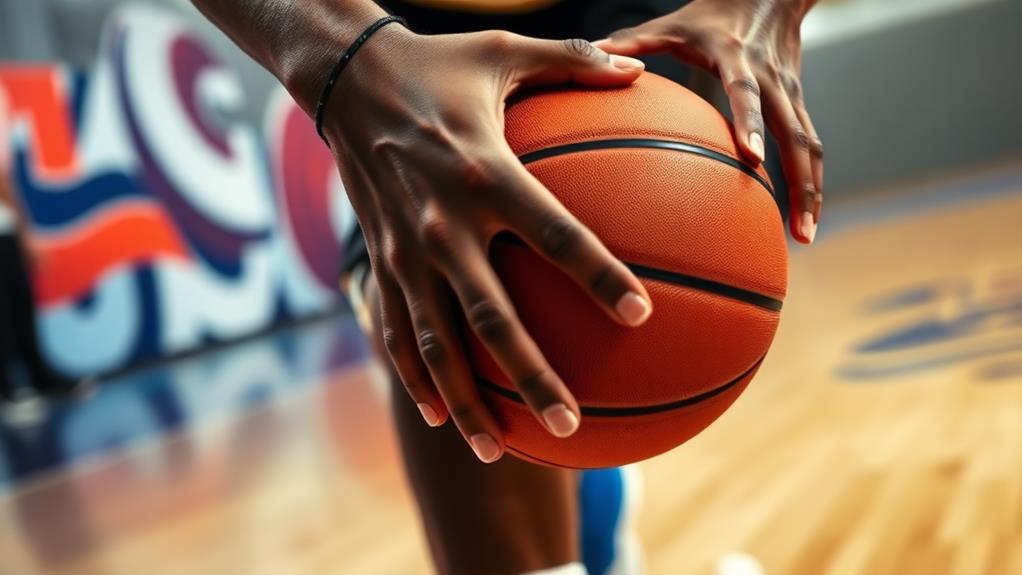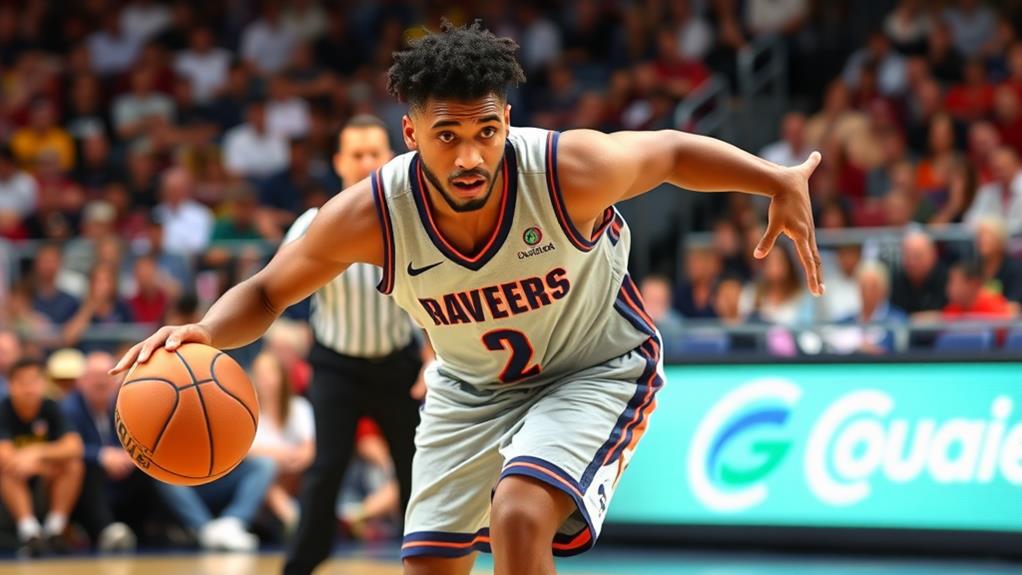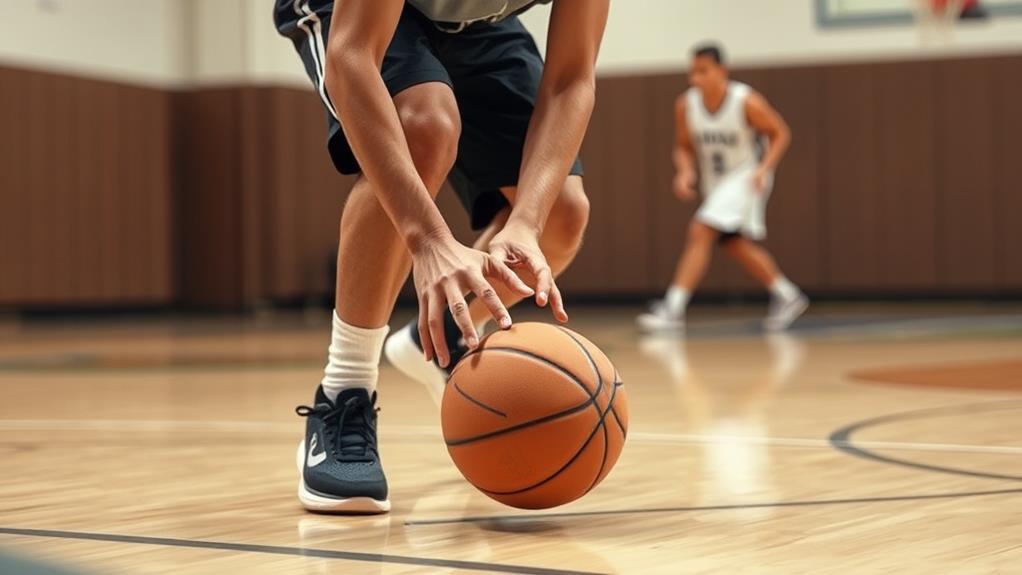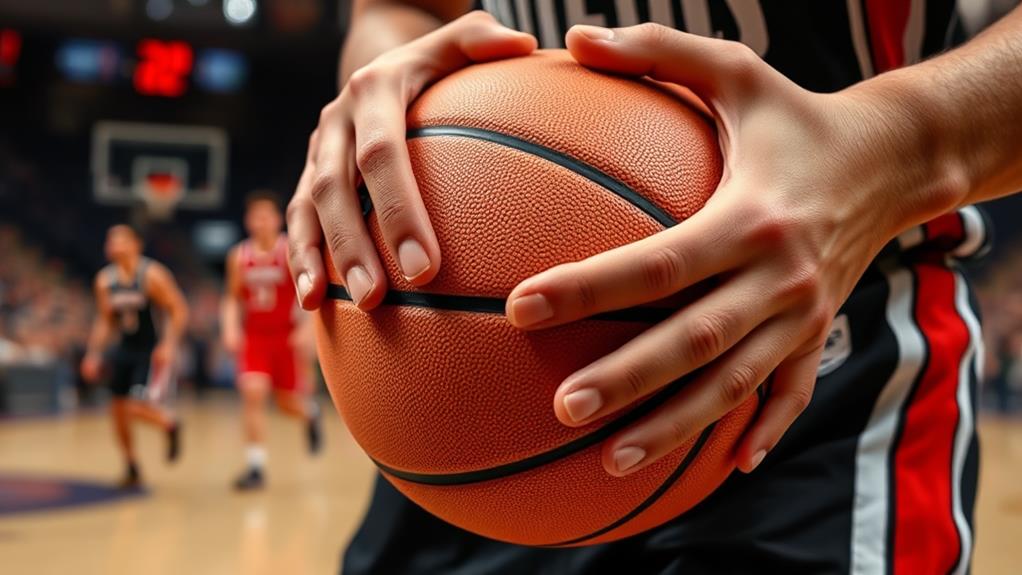
Understanding the Carry Violation in Basketball
October 10, 2024Understanding the carry violation in basketball is key for every player. It happens when your hand is underneath the ball while dribbling or when you pause your dribble before starting again with one hand. This violation's illegal because it creates an unfair advantage, disrupting game flow and strategy. If you get called for a carry, your team loses possession, which can be essential during tight moments. Knowing the rules and mastering proper dribbling techniques can help you avoid such mistakes. Stick around, and you'll uncover tips to keep your game sharp and your play mistake-free.
Definition of Carry Violation
A carry violation frequently occurs when you're dribbling the basketball. This happens when you, as a player, put your hand underneath the ball while dribbling, fundamentally holding it for a moment instead of maintaining a proper dribble. The NBA defines a carry as any part of your hand being under the ball during the dribble, which disrupts the flow and rhythm of the game.
Understanding the significance of maintaining proper dribbling techniques, similar to how soccer players must comply with equipment and attire regulations, can also help prevent violations.
Another aspect of a carry violation involves resuming a dribble after pausing with the ball in one hand. Unlike a double dribble, where you completely stop dribbling and then start again, a carry occurs during a brief pause while still dribbling. This subtlety can lead to confusion, but understanding this distinction is essential for you as a player.
Avoiding carry violations is critical to maintaining possession of the ball and preventing turnovers. When you know how to properly dribble without committing a carry, you can enhance your gameplay and keep the focus on scoring.
Reasons for Carrying Being Illegal
The legality of carrying in basketball hinges on its potential to disrupt fair play. When an offensive player manipulates their dribble through illegal means, it creates an unfair advantage, making it tougher for defenders to anticipate their moves. This imbalance could lead to a game where skill development takes a backseat, as players might lean on illegal techniques instead of honing their legitimate dribbling skills.
Modern defensive strategies are built upon players' ability to anticipate movements and react accordingly, which could be severely compromised if carrying were permitted, as effective communication is crucial for maintaining defensive integrity.
Maintaining control of the ball during dribbling is crucial, and the rules require players to keep their hands on top of the ball. This promotes fairness and guarantees that the game remains competitive. Allowing carrying would undermine the very essence of basketball as a skill-based sport, blurring the lines between proficient play and violations.
Referees are trained to spot carrying violations to uphold the integrity of the game. By enforcing this rule, they prevent players from employing unnatural movements that could hinder defensive efforts and enhance the offensive player's ability to dominate the court.
Ultimately, the prohibition of carrying supports a balanced gameplay environment where skill and strategy shine.
Penalties for Carrying

Carrying violations come with specific penalties that affect the game's flow and strategy. When you're caught carrying the basketball, it results in a dead-ball turnover, much like a traveling violation. This means your team loses possession of the ball, giving the opposing team an opportunity to score.
The consequences of such turnovers can be particularly damaging during essential moments of the game, similar to how relegation battles in soccer can greatly impact a team's future. In high school and college basketball, once the violation in basketball is called, the ball is thrown in from either the sideline or baseline.
In the NBA, however, the inbounding takes place from the area between the free throw line and the baseline. This difference in procedure doesn't change the fundamental impact of the penalty: it disrupts the pace of the game and can shift momentum.
The intent behind penalizing carrying is to maintain fairness and balance between offensive and defensive players. By enforcing these rules, referees help guarantee that players can compete on an even playing field.
Understanding the penalties for carrying is vital for you as a player. It not only helps you avoid unnecessary turnovers but also keeps the game flowing smoothly, allowing both teams to showcase their skills effectively. The impact on team dynamics resulting from these violations can resonate throughout the course of the game.
Frequency of Carrying Calls
You might've noticed that carrying calls are rarely made during games, leading to questions about referee consistency.
This inconsistency can impact not just the players' awareness of the rules, but also the overall flow of the game.
Often, fans and players alike are left wondering about the nuances of the game, much like how soccer enthusiasts engage in discussions about popular moves.
Understanding these dynamics can help you appreciate the complexities referees face in real-time situations.
Referee Call Consistency
During games, the consistency of carrying calls can fluctuate considerably, impacting both players and coaches. Referees are trained to spot carrying violations, particularly when a player's hand rests underneath the ball while dribbling. However, the frequency of these calls varies greatly. Some players might gain an advantage when referees overlook certain infractions due to the fast-paced nature of the game.
This inconsistency can create confusion on the court, as players may not fully understand what constitutes a carrying violation. Often, spectators misinterpret legal dribbling techniques for illegal carries, adding to the overall ambiguity.
Referee discretion plays a significant role here; the same action might be called a carry in one game but overlooked in another. This variability can frustrate both players and coaches, as they may feel at the mercy of inconsistent officiating.
Ongoing discussions within the NBA highlight this issue, with some advocating for stricter enforcement of carrying calls to maintain the game's integrity. Ultimately, understanding these discrepancies in referee calls can help players better navigate the complexities of the game.
Player Awareness and Education
The inconsistency in carrying calls highlights a need for increased player awareness and education regarding these violations. As a player who's dribbling, understanding the rules around carrying can greatly improve your game and maintain the integrity of play.
Here are four key points to contemplate:
- Legal Dribbling Techniques: Recognize which moves, like the pocket dribble, are legal. They might look similar to a carry but aren't classified in that manner.
- Referee Training: Understand that referees undergo specialized training to differentiate between legal moves and violations, which can sometimes lead to confusion during fast-paced games.
- Skill Development: Focus on enhancing your dribbling skills to avoid unintentional carries. A solid grasp of legal dribbling can help you retain possession of the ball.
- Fan Perspective: Be aware that misinterpretations of your moves can arise. Educating yourself and others about carrying in basketball can foster appreciation for the sport.
Impact on Game Flow
Carrying calls play an essential role in shaping the rhythm of a basketball game. When referees call carrying violations, it disrupts the flow and can change the momentum. In the NBA, these calls are made less frequently than in other leagues, which raises concerns about officiating inconsistency. This leniency allows players to utilize advanced dribbling techniques that mightn't technically meet the criteria for a carry, leading to confusion among fans and players alike.
Because of the fast-paced nature of the game, referees often face challenges in making quick decisions. What might seem like a carrying violation can sometimes be a legal maneuver, making it a subjective judgment call. This blurring of lines can considerably impact game strategy, as teams may exploit the officiating inconsistency to gain an edge.
If a player knows that carrying violations aren't being called, they may feel encouraged to push the boundaries of their dribbling techniques. Ultimately, the infrequency of carrying calls plays an important role in how teams approach the game, influencing both their tactics and the overall experience for spectators.
Teaching Proper Dribbling Techniques

To improve your dribbling, you need to focus on common mistakes like improper hand placement and high dribbling.
Mastering ball control techniques is essential for enhancing your overall dribbling ability. Incorporating effective drills can help you reinforce these skills while minimizing the risk of carrying violations.
Common Dribbling Mistakes
Dribbling mistakes can undermine a player's effectiveness on the court, and understanding how to avoid them is vital for skill development.
To enhance your dribbling skills, pay attention to these common mistakes:
- Hand Placement: Avoid placing your hand underneath the ball while you dribble it. Proper hand placement keeps the ball secure and helps prevent carrying violations.
- High Dribbling: Don't dribble the ball too high, as it can lead to losing control and unintentional pauses in your dribble. Keep it low and close to your body.
- Pausing the Dribble: Maintaining a constant dribble is essential. If you pause, you risk carrying the ball, which can result in a turnover.
- Ignoring the Rules: Educate yourself about carrying violations. Being mindful of the rules surrounding your hand position can greatly decrease unintentional mistakes.
Effective Dribbling Drills
Improving your dribbling skills requires a strong focus on technique, and engaging in effective drills can considerably enhance your performance on the court. Start by incorporating drills that emphasize proper hand placement. Make sure your palms face down to avoid situations where holding the ball may lead to a carry violation.
Small-sided games are excellent for simulating real-game scenarios. They challenge you to maintain control of the ball while dribbling without committing carries. Zig-zag drills are another fantastic way to practice continuous dribble movements, reinforcing the importance of not pausing while handling the ball.
Additionally, implement cone drills to help you practice quick direction changes, which are vital for developing proper techniques. Remember, when you're dribbling, maintaining a low center of gravity enhances your balance and control, reducing the risk of being called a carry.
These drills not only improve your skills but also build your confidence. By focusing on these techniques, you'll find that dribbling may not put you at a disadvantage, but instead, elevate your game to a new level.
Continue to dribble effectively, and watch your performance soar.
Importance of Hand Placement
Often, players overlook the significance of hand placement when dribbling, yet it plays a vital role in maintaining control and legality. As a basketball player, understanding the importance of hand placement can save you from unnecessary carry violations.
Here are some key points to keep in mind:
- Palms Down: Keep your palms facing down while dribbling to maintain control and avoid carrying the ball.
- Fingertips First: Use your fingertips to push the ball instead of letting it rest in your palm. This prevents the "hand under the ball" position, which can lead to a carry call.
- Consistent Dribble: Work on maintaining a steady dribble, allowing you to react quickly during gameplay without losing control.
- Practice Drills: Incorporate dribbling drills that focus on hand positioning to enhance your ball-handling skills and reduce the chances of carrying infractions.
Impact of Carrying on Gameplay
Carrying violations play a significant role in shaping the dynamics of a basketball game. When a player commits a carry, it results in a dead-ball turnover, halting the offensive team's progress and giving possession to the opposing team. This not only disrupts the flow of the game but also impacts the offensive team's momentum, forcing them to adjust their strategy to avoid further penalties.
Additionally, understanding the implications of data-driven strategies can help players reduce the likelihood of these violations by optimizing their dribbling techniques. The enforcement of carrying rules maintains fairness, preventing players from using illegal dribbling techniques that could give them an unfair advantage. Defensive players often exploit this by applying pressure, pushing offensive players into situations where they might inadvertently commit a carry.
Understanding and adhering to carrying rules is essential for player development as it encourages the mastery of legitimate dribbling techniques. By focusing on proper skills, you'll enhance your overall gameplay and reduce the likelihood of turnovers.
Ultimately, the implications of carrying violations extend beyond individual plays; they can shift the outcome of a game, influencing not only your performance but also the team's strategy and cohesion on the court.
Common Misconceptions About Carrying

How well do you really understand the rules around carrying in basketball? Many players hold misconceptions that can affect their gameplay. Here are some common myths that you should clear up:
- Holding the Ball While Dribbling: It's not a carry just because you're holding the ball; it's only called when a player has their hand underneath the ball without dribbling. Mastering the rules around carrying can provide a strategic advantage for your team's offensive plays.
- Carrying vs. Traveling: Carrying occurs when you momentarily hold the ball during a dribble, while traveling is taking steps without dribbling.
- Only in the NBA: Some think carrying is enforced only in the NBA, but it's a rule that applies at all levels, including high school and college.
- Resuming Dribbling: Many believe they can start dribbling again after stopping the ball, but that's a double dribble violation instead of carrying.
Understanding these distinctions can help you avoid unnecessary turnovers and keep your game sharp.
Don't let misconceptions hold you back; knowing the rules can help your team move the ball from one point to another effectively.
Conclusion
To sum up, understanding carry violations helps you appreciate the nuances of basketball. Did you know that in the NBA, carry calls are rare, making up less than 1% of all fouls? This highlights how often players push the boundaries of the rules while maintaining their skill. By mastering proper dribbling techniques, you not only avoid penalties but also elevate your game. So next time you're on the court, keep an eye on your ball control!


